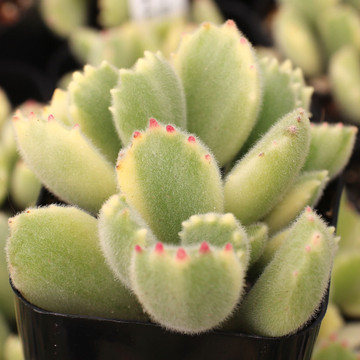Cotyledon (koh-tuh-LEE-dahn) is a variable group of succulents, and most make excellent indoor plants. They tend to be white and powdery or green and fuzzy, with red accents appearing when grown in bright sun. This easy-to-grow group also produces coral, bell-shaped flowers that attract pollinators.
PLEASE NOTE: Some Cotyledon are mildly toxic if consumed
APPEARANCE
- Colors: Most are either green with red leaf tips or silvery to white. The pale, glaucous look comes from a coating of natural wax that protects the plant in direct sun.
- Form: Tends to grow as a small, stemmed subshrub or loose rosette of leaves. The leaves are often thick and round but can vary greatly in size and shape.
- Flowers: Produces tubular, bell-shaped flowers in peachy coral tones that hang from tall, sturdy bloom stalks. The flowers are large with curled-back petals to allow for pollination by sunbirds in the wild.
CARE
- Light: Somewhat flexible, though more exposure to direct sun will intensify red pigments in the leaf tips. To grow indoors, keep near a sunny window or under a grow light.
- Soil: Choose a gritty, well-draining soil with plenty of mineral grit, such as a succulent and cactus soil from your local garden center. If planting in containers, we strongly recommend pots with drainage holes. (Succulent Soil)
- Water: Fleshy succulent leaves are prone to rot from over-watering. Water deeply enough for water to run out of drainage hole, then wait for soil to completely dry before watering again.
- Hardiness: These are soft/tender succulents and therefore will not tolerate hard frosts. (What’s my zone?)
- Propagation: Easy to re-grow roots on stem cuttings or mature leaves. (Succulent Cuttings Guide)
NOTES FROM THE NURSERY
Cotyledon was one of the early genera when succulents were first being described in scientific literature. It was an enormous genus, acting as a catch-all for all plants from the Crassulaceae family that had fused petals, including Echeveria, Rosularia, and Dudleya. Now it’s been stripped down to only 10 species with most cultivated varieties derived from just one species: C. orbiculata.
Most are native to rocky habitats and cliffsides in South Africa and can acclimate to full or partial sun. With rapid drainage and deep but infrequent water, Cotyledon are extremely easy-to-grow and rarely have issues with pests or diseases.
READ MORE






